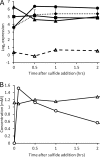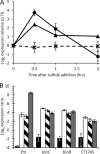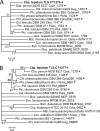Chlorobaculum tepidum TLS displays a complex transcriptional response to sulfide addition
- PMID: 23161024
- PMCID: PMC3553837
- DOI: 10.1128/JB.01342-12
Chlorobaculum tepidum TLS displays a complex transcriptional response to sulfide addition
Abstract
Chlorobaculum tepidum is a green sulfur bacterium (GSB) that is a model system for phototrophic sulfur oxidation. Despite over 2 decades of research, conspicuous gaps exist in our understanding of its electron donor metabolism and regulation. RNA sequencing (RNA-seq) was used to provide a global picture of the C. tepidum transcriptome during growth on thiosulfate as the sole electron donor and at time points following the addition of sulfide to such a culture. Following sulfide addition, 121 to 150 protein-coding genes displayed significant changes in expression depending upon the time point. These changes included a rapid decrease in expression of thiosulfate and elemental sulfur oxidation genes. Genes and gene loci with increased expression included CT1087, encoding a sulfide:quinone oxidoreductase required for growth in high sulfide concentrations; a polysulfide reductase-like complex operon, psrABC (CT0496 to CT0494); and, surprisingly, a large cluster of genes involved in iron acquisition. Finally, two genes that are conserved as a cassette in anaerobic bacteria and archaea, CT1276 and CT1277, displayed a strong increase in expression. The CT1277 gene product contains a DNA-binding domain, suggesting a role for it in sulfide-dependent gene expression changes.
Figures





 , dashed line; mean ± SD of 59 genes). (B) qRT-PCR expression analysis of RNA harvested from cultures grown on thiosulfate (black) or 30 min after addition of sulfide to 2 mM (white) or 6 mM (stripes) and trace metal limitation (gray). Expression is reported as log2 of the expression ratio relative to sigA, and values are means ± SDs among all technical replicates (n ≥ 5).
, dashed line; mean ± SD of 59 genes). (B) qRT-PCR expression analysis of RNA harvested from cultures grown on thiosulfate (black) or 30 min after addition of sulfide to 2 mM (white) or 6 mM (stripes) and trace metal limitation (gray). Expression is reported as log2 of the expression ratio relative to sigA, and values are means ± SDs among all technical replicates (n ≥ 5).
 , dashed line) measured by RNA-seq following the addition of sulfide. (B) qRT-PCR expression analysis of RNA harvested from cultures grown on thiosulfate (black) or 30 min after addition of sulfide to 2 mM (white) or 6 mM (stripes) and trace metal limitation (gray). Expression ratios are relative to sigA and are means ± SDs among all technical replicates (n ≥ 5).
, dashed line) measured by RNA-seq following the addition of sulfide. (B) qRT-PCR expression analysis of RNA harvested from cultures grown on thiosulfate (black) or 30 min after addition of sulfide to 2 mM (white) or 6 mM (stripes) and trace metal limitation (gray). Expression ratios are relative to sigA and are means ± SDs among all technical replicates (n ≥ 5).
Similar articles
-
Differential RNA Sequencing Implicates Sulfide as the Master Regulator of S0 Metabolism in Chlorobaculum tepidum and Other Green Sulfur Bacteria.Appl Environ Microbiol. 2018 Jan 17;84(3):e01966-17. doi: 10.1128/AEM.01966-17. Print 2018 Feb 1. Appl Environ Microbiol. 2018. PMID: 29150516 Free PMC article.
-
Functional analysis of three sulfide:quinone oxidoreductase homologs in Chlorobaculum tepidum.J Bacteriol. 2009 Feb;191(3):1026-34. doi: 10.1128/JB.01154-08. Epub 2008 Nov 21. J Bacteriol. 2009. PMID: 19028893 Free PMC article.
-
Sulfur globule oxidation in green sulfur bacteria is dependent on the dissimilatory sulfite reductase system.Microbiology (Reading). 2011 Apr;157(Pt 4):1229-1239. doi: 10.1099/mic.0.044669-0. Epub 2011 Jan 13. Microbiology (Reading). 2011. PMID: 21233162
-
Inorganic sulfur oxidizing system in green sulfur bacteria.Photosynth Res. 2010 Jun;104(2-3):163-76. doi: 10.1007/s11120-010-9531-2. Epub 2010 Feb 9. Photosynth Res. 2010. PMID: 20143161 Review.
-
Sulfur metabolism in phototrophic sulfur bacteria.Adv Microb Physiol. 2009;54:103-200. doi: 10.1016/S0065-2911(08)00002-7. Adv Microb Physiol. 2009. PMID: 18929068 Review.
Cited by
-
Chlorobaculum tepidum Modulates Amino Acid Composition in Response to Energy Availability, as Revealed by a Systematic Exploration of the Energy Landscape of Phototrophic Sulfur Oxidation.Appl Environ Microbiol. 2016 Oct 14;82(21):6431-6439. doi: 10.1128/AEM.02111-16. Print 2016 Nov 1. Appl Environ Microbiol. 2016. PMID: 27565613 Free PMC article.
-
A comparative quantitative proteomic study identifies new proteins relevant for sulfur oxidation in the purple sulfur bacterium Allochromatium vinosum.Appl Environ Microbiol. 2014 Apr;80(7):2279-92. doi: 10.1128/AEM.04182-13. Epub 2014 Jan 31. Appl Environ Microbiol. 2014. PMID: 24487535 Free PMC article.
-
The bacterial sulfur cycle in expanding dysoxic and euxinic marine waters.Environ Microbiol. 2021 Jun;23(6):2834-2857. doi: 10.1111/1462-2920.15265. Epub 2020 Oct 18. Environ Microbiol. 2021. PMID: 33000514 Free PMC article. Review.
-
Taxonomic and functional heterogeneity of the gill microbiome in a symbiotic coastal mangrove lucinid species.ISME J. 2019 Apr;13(4):902-920. doi: 10.1038/s41396-018-0318-3. Epub 2018 Dec 5. ISME J. 2019. PMID: 30518817 Free PMC article.
-
Differential RNA Sequencing Implicates Sulfide as the Master Regulator of S0 Metabolism in Chlorobaculum tepidum and Other Green Sulfur Bacteria.Appl Environ Microbiol. 2018 Jan 17;84(3):e01966-17. doi: 10.1128/AEM.01966-17. Print 2018 Feb 1. Appl Environ Microbiol. 2018. PMID: 29150516 Free PMC article.
References
-
- Beatty JT, Overmann J, Lince MT, Manske AK, Lang AS, Blankenship RE, Dover CLV, Martinson TA, Plumley FG, Buchanan BB. 2005. An obligately photosynthetic bacterial anaerobe from a deep-sea hydrothermal vent. Proc. Natl. Acad. Sci. U. S. A. 102:9306–9310 doi:10.1073/pnas.0503674102. - DOI - PMC - PubMed
-
- Jørgensen BB, Fossing Wirsen CO, Jannasch HW. 1991. Sulfide oxidation in the anoxic Black Sea chemocline. Deep Sea Res. A 38:S1083–S1103 doi:10.1016/S0198-0149(10)80025-1. - DOI
-
- Petri R, Imhoff J. 2001. Genetic analysis of sea-ice bacterial communities of the Western Baltic Sea using an improved double gradient method. Polar Biol. 24:252–257 doi:10.1007/s003000000205. - DOI
-
- Wahlund TM, Woese CR, Castenholz RW, Madigan MT. 1991. A thermophilic green sulfur bacterium from New Zealand hot springs, Chlorobium tepidum sp. nov. Arch. Microbiol. 156:81–90 doi:10.1007/BF00290978. - DOI
-
- Imhoff J, Thiel V. 2010. Phylogeny and taxonomy of Chlorobiaceae. Photosynth. Res. 104:123–136 doi:10.1007/s11120-009-9510-7. - DOI - PubMed
Publication types
MeSH terms
Substances
Grants and funding
LinkOut - more resources
Full Text Sources

